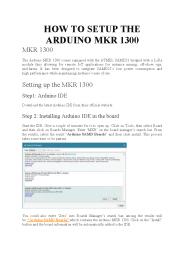Price Of Arduino by ROBOMART
About This Presentation
Title:
Price Of Arduino by ROBOMART
Description:
Buy Arduino Board at affordable price from Robomart. For further details please click the link below: – PowerPoint PPT presentation
Number of Views:12
Slides: 8
Provided by:
juhi786
Tags:
price_arduino | flash | free | online_training | powerpoint | ppt | pptx | presentation | slide_show | slideshow
Transcript and Presenter's Notes
Title: Price Of Arduino by ROBOMART
1
ARDUINO BOARD
2
ARDUINO UNO BOARD
- The Arduino Uno Board differs from all preceding
boards in that it does not use the
FTDI USB-to-serial driver chip. Instead, it
features the Atmega16U2Atmega8U2 up to version
R2) programmed as a USB-to-serial converter. - It has 14 digital input/output pins, 6 analog
inputs, A16 MHz ceramic resonator, A USB
connection, A power jack, An ICSP header and a
reset button. It contains everything needed to
support the microcontroller simply connect it to
a computer with a USB cable or power it with a
AC-to-DC adapter or battery to get started.
3
HOW IT LOOKS
4
Features of Arduino Uno
- Microcontroller ATmeg328.
- Operating Voltage 5V.
- Input Voltage 7-12V.
- Digital I/O Pins 14 (of which 6 provide PWM
output). - Analog Input Pins 6.
- DC Current 40 mA.
- DC Current 50 mA.
- Flash Memory 32 KB.
- SRAM 2 KB.
- EEPROM 1 KB.
- Clock Speed 16 MHz.
5
Applications of Arduino Uno
- DIY project prototyping.
- Developing varied varieties of projects that
require a code based control. - Automation System development.
- Learning AVR programming.Entry level circuit
designing.
6
CONTACT US
- B5, C Block Sector 31, Above Indian Overseas
Bank, Noida, Uttar Pradesh 201301, India. -
Mob91-8744000555
- Tel
91-120-4317229 - Email-Id
admin_at_robomart.com - Web
https//www.robomart.com
7
THANK YOU
Write a Comment
User Comments (0)
Recommended
«
/ »
Page of
«
/ »
CrystalGraphics Presentations
Related Presentations































